Home
Animals
Mammal
Anteaters
Echidna or Spiny Anteater
Echidna or Spiny Anteater is the name given to two species of animals
found in Australia, Tasmania and New Guinea.
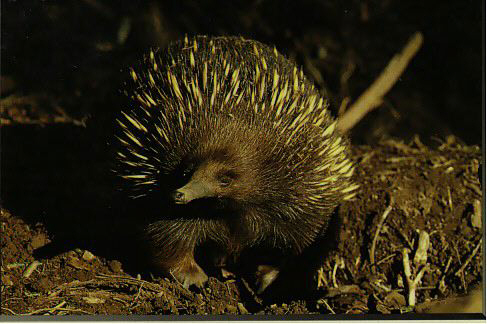 The
much better known of these is Tachyglossus Aculeatus, (Which means
"fast-tongued, spiny", pictured at left), also known as the
"short-beaked echidna." It is a medium sized animal, about
a foot long and weighing around 15.4 pounds, females are somewhat
smaller, with a smallish head attached to a stocky body, and a long
cylindrical snout. Its color varies from blond to black, but darker
colors are more common. The echidna is covered on its back and sides
with stout spines mixed with bristly hair, and superficially resemble
a large hedgehog. It is common throughout Australia and Tasmania. It
is much less common in coastal areas of New Guinea.
The
much better known of these is Tachyglossus Aculeatus, (Which means
"fast-tongued, spiny", pictured at left), also known as the
"short-beaked echidna." It is a medium sized animal, about
a foot long and weighing around 15.4 pounds, females are somewhat
smaller, with a smallish head attached to a stocky body, and a long
cylindrical snout. Its color varies from blond to black, but darker
colors are more common. The echidna is covered on its back and sides
with stout spines mixed with bristly hair, and superficially resemble
a large hedgehog. It is common throughout Australia and Tasmania. It
is much less common in coastal areas of New Guinea.
A second species of Echidna is given the scientific name Zaglossus
Bruijni 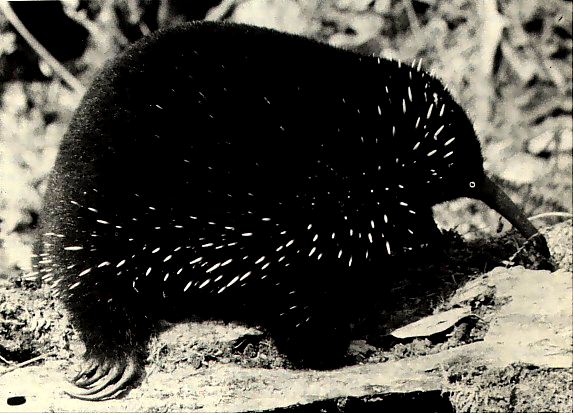 (Zaglossus
means "Great Tongue", Bruijni refers a Dutch trader who
collected the first known specimen; pictured at right), also called
the "Long-beaked Echidna." It is considerably bigger that
Tachyglossus, growing as large as 36.3 pounds, and has a longer snout
curving downwards. The spines tend to be shorter than on
Tachyglossus, and are often almost wholly concealed by fur, except
along the flanks. Its legs are longer than in its more rotund short-beaked
cousin, and it is sometimes described as more pig-like. It is found
only in highland regions of New Guinea, and is quite rare. Experts
view it as vulnerable to extinction. Unfortunately, very little is
known about Zaglossus's biology, behavior or ecological role.
(Zaglossus
means "Great Tongue", Bruijni refers a Dutch trader who
collected the first known specimen; pictured at right), also called
the "Long-beaked Echidna." It is considerably bigger that
Tachyglossus, growing as large as 36.3 pounds, and has a longer snout
curving downwards. The spines tend to be shorter than on
Tachyglossus, and are often almost wholly concealed by fur, except
along the flanks. Its legs are longer than in its more rotund short-beaked
cousin, and it is sometimes described as more pig-like. It is found
only in highland regions of New Guinea, and is quite rare. Experts
view it as vulnerable to extinction. Unfortunately, very little is
known about Zaglossus's biology, behavior or ecological role.
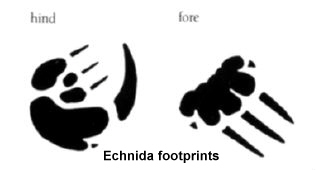 Echidnas
are members of the Monotreme, one of the three great orders of
mammals. Monotremes are mammals that lay eggs, and have only one
external opening, called a cloaca, through which all waste matter and
reproductive substances pass. (The word Monotreme means "one opening.")
Echidnas
are members of the Monotreme, one of the three great orders of
mammals. Monotremes are mammals that lay eggs, and have only one
external opening, called a cloaca, through which all waste matter and
reproductive substances pass. (The word Monotreme means "one opening.")
The other two types of mammals are Marsupials, like the Kangaroo,
which give live birth to very underdeveloped young that then must
develop in a pouch, and Placentals, which, like Human Beings, have
developed methods to give birth to fairly well developed live young.
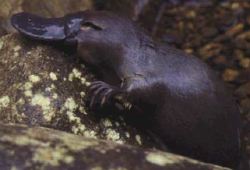 Besides
the Echidna, the only other living Monotreme is the Duck-Billed
Platypus (pictured at right), also native to Australia and Tasmania,
which is therefore the Echidna's closest living relative. Echidnas
vary in appearance, generally with climate. Echidnas in northern
warmer zones tend to have more spines, while those in colder climates
farther south tend to have more fur. The Tasmanian version of the
Echidna has so much fur; the spines only show through on the flanks.
Attempts have been made to classify echidnas into various subspecies
based on this feature, and other attributes, like the relative size
of the different toes. However, today most experts agree that the
variation from one population to another is a smooth transition and
creating subspecies barriers is a very artificial process. Echidnas
also vary in color, the predominant shades being black or dark brown,
but "blonde" are also not uncommon, and are frequently
mistaken for Albinos, which they are not. The Echidnas of Kangaroo
Island, off South Australia, are predominantly blonde.
Besides
the Echidna, the only other living Monotreme is the Duck-Billed
Platypus (pictured at right), also native to Australia and Tasmania,
which is therefore the Echidna's closest living relative. Echidnas
vary in appearance, generally with climate. Echidnas in northern
warmer zones tend to have more spines, while those in colder climates
farther south tend to have more fur. The Tasmanian version of the
Echidna has so much fur; the spines only show through on the flanks.
Attempts have been made to classify echidnas into various subspecies
based on this feature, and other attributes, like the relative size
of the different toes. However, today most experts agree that the
variation from one population to another is a smooth transition and
creating subspecies barriers is a very artificial process. Echidnas
also vary in color, the predominant shades being black or dark brown,
but "blonde" are also not uncommon, and are frequently
mistaken for Albinos, which they are not. The Echidnas of Kangaroo
Island, off South Australia, are predominantly blonde.
Echidnas are exceedingly long-lived for their size. One captive
Echidna is documented to have lived at least 49 years. Compared to
say, a cat, which is of similar mass, this is simply ancient. This is
another sign of the essential difference of Echidna's from other mammals
Echidnas, very rarely, can make a sort of cooing sound, like a dove.
Echidna tongues are 15-18 centimeters long and oval in cross section,
they can shoot out of 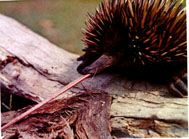 the
tiny mouth with lightening speed and be bent in U-shapes to follow
ant tunnels. The tongue is coated with a secretion with the
consistency of treacle. Prey sticks to the tongue, and then is
removed in the mouth by spines that line the roof. The Echidna has no
teeth; food is ground up with special hard pads on the pack of the
tongue and top of the mouth. Echidnas live in some areas where there
is no water available at least part of the year, and is something of
a puzzle how they get their water. It has been calculated that it
might be possible for echidnas to get the minimum water they need
from their food. Echidnas have also been observed to use a common
trick of desert animals, namely licking the early morning dew from
plants. Echidnas show greater variation in body temperature than do
other mammals, depending on activity levels and air temperature.
Their body temperature never exceeds 34 degrees Celsius, the lowest
of any mammal. Echidna metabolic rates, measured as oxygen
consumption per unit weight under conditions of inactivity, is also
the lowest of all mammals (except the platypus.) After mating, there
is approximately a 21 to 28 day gestation period before an egg is
laid. After about 10 days, the Echidna hatchling emerges from the egg
with the aid of a single egg tooth and a carbuncle, a hard bump on
its nose. Both the egg tooth and the carbuncle disappear after
hatching, but the egg tooth is the only tooth any echidna ever has.
the
tiny mouth with lightening speed and be bent in U-shapes to follow
ant tunnels. The tongue is coated with a secretion with the
consistency of treacle. Prey sticks to the tongue, and then is
removed in the mouth by spines that line the roof. The Echidna has no
teeth; food is ground up with special hard pads on the pack of the
tongue and top of the mouth. Echidnas live in some areas where there
is no water available at least part of the year, and is something of
a puzzle how they get their water. It has been calculated that it
might be possible for echidnas to get the minimum water they need
from their food. Echidnas have also been observed to use a common
trick of desert animals, namely licking the early morning dew from
plants. Echidnas show greater variation in body temperature than do
other mammals, depending on activity levels and air temperature.
Their body temperature never exceeds 34 degrees Celsius, the lowest
of any mammal. Echidna metabolic rates, measured as oxygen
consumption per unit weight under conditions of inactivity, is also
the lowest of all mammals (except the platypus.) After mating, there
is approximately a 21 to 28 day gestation period before an egg is
laid. After about 10 days, the Echidna hatchling emerges from the egg
with the aid of a single egg tooth and a carbuncle, a hard bump on
its nose. Both the egg tooth and the carbuncle disappear after
hatching, but the egg tooth is the only tooth any echidna ever has.
The hatchling is semi-transparent and 13-14 millimeters long at
birth. Once hatched, the echidna young, termed a "puggle",
remains in the pouch and receives milk from two milk patches towards
the front end. Echidna milk is a fascinating substance. First of all
it contains almost none of the milk sugar, lactose, which is most
important in all placental and marsupial mammal milk. Instead it has
completely different sugars, fucosyllactate and syalyllactose. This
means that Echidnas cannot digest milk from other mammals and should
never be fed milk in captivity. In addition, echidna milk, early in
lactation, is pink in color, due to high iron content. It also grows
thicker as the young echidna gets bigger, going from quite dilute to
over 50% solids by the time the young is weaned.
http://yoyo.cc.monash.edu.au/~tzvi/Echid_I.html
 The
much better known of these is Tachyglossus Aculeatus, (Which means
"fast-tongued, spiny", pictured at left), also known as the
"short-beaked echidna." It is a medium sized animal, about
a foot long and weighing around 15.4 pounds, females are somewhat
smaller, with a smallish head attached to a stocky body, and a long
cylindrical snout. Its color varies from blond to black, but darker
colors are more common. The echidna is covered on its back and sides
with stout spines mixed with bristly hair, and superficially resemble
a large hedgehog. It is common throughout Australia and Tasmania. It
is much less common in coastal areas of New Guinea.
The
much better known of these is Tachyglossus Aculeatus, (Which means
"fast-tongued, spiny", pictured at left), also known as the
"short-beaked echidna." It is a medium sized animal, about
a foot long and weighing around 15.4 pounds, females are somewhat
smaller, with a smallish head attached to a stocky body, and a long
cylindrical snout. Its color varies from blond to black, but darker
colors are more common. The echidna is covered on its back and sides
with stout spines mixed with bristly hair, and superficially resemble
a large hedgehog. It is common throughout Australia and Tasmania. It
is much less common in coastal areas of New Guinea. (Zaglossus
means "Great Tongue", Bruijni refers a Dutch trader who
collected the first known specimen; pictured at right), also called
the "Long-beaked Echidna." It is considerably bigger that
Tachyglossus, growing as large as 36.3 pounds, and has a longer snout
curving downwards. The spines tend to be shorter than on
Tachyglossus, and are often almost wholly concealed by fur, except
along the flanks. Its legs are longer than in its more rotund short-beaked
cousin, and it is sometimes described as more pig-like. It is found
only in highland regions of New Guinea, and is quite rare. Experts
view it as vulnerable to extinction. Unfortunately, very little is
known about Zaglossus's biology, behavior or ecological role.
(Zaglossus
means "Great Tongue", Bruijni refers a Dutch trader who
collected the first known specimen; pictured at right), also called
the "Long-beaked Echidna." It is considerably bigger that
Tachyglossus, growing as large as 36.3 pounds, and has a longer snout
curving downwards. The spines tend to be shorter than on
Tachyglossus, and are often almost wholly concealed by fur, except
along the flanks. Its legs are longer than in its more rotund short-beaked
cousin, and it is sometimes described as more pig-like. It is found
only in highland regions of New Guinea, and is quite rare. Experts
view it as vulnerable to extinction. Unfortunately, very little is
known about Zaglossus's biology, behavior or ecological role. Echidnas
are members of the Monotreme, one of the three great orders of
mammals. Monotremes are mammals that lay eggs, and have only one
external opening, called a cloaca, through which all waste matter and
reproductive substances pass. (The word Monotreme means "one opening.")
Echidnas
are members of the Monotreme, one of the three great orders of
mammals. Monotremes are mammals that lay eggs, and have only one
external opening, called a cloaca, through which all waste matter and
reproductive substances pass. (The word Monotreme means "one opening.") Besides
the Echidna, the only other living Monotreme is the Duck-Billed
Platypus (pictured at right), also native to Australia and Tasmania,
which is therefore the Echidna's closest living relative. Echidnas
vary in appearance, generally with climate. Echidnas in northern
warmer zones tend to have more spines, while those in colder climates
farther south tend to have more fur. The Tasmanian version of the
Echidna has so much fur; the spines only show through on the flanks.
Attempts have been made to classify echidnas into various subspecies
based on this feature, and other attributes, like the relative size
of the different toes. However, today most experts agree that the
variation from one population to another is a smooth transition and
creating subspecies barriers is a very artificial process. Echidnas
also vary in color, the predominant shades being black or dark brown,
but "blonde" are also not uncommon, and are frequently
mistaken for Albinos, which they are not. The Echidnas of Kangaroo
Island, off South Australia, are predominantly blonde.
Besides
the Echidna, the only other living Monotreme is the Duck-Billed
Platypus (pictured at right), also native to Australia and Tasmania,
which is therefore the Echidna's closest living relative. Echidnas
vary in appearance, generally with climate. Echidnas in northern
warmer zones tend to have more spines, while those in colder climates
farther south tend to have more fur. The Tasmanian version of the
Echidna has so much fur; the spines only show through on the flanks.
Attempts have been made to classify echidnas into various subspecies
based on this feature, and other attributes, like the relative size
of the different toes. However, today most experts agree that the
variation from one population to another is a smooth transition and
creating subspecies barriers is a very artificial process. Echidnas
also vary in color, the predominant shades being black or dark brown,
but "blonde" are also not uncommon, and are frequently
mistaken for Albinos, which they are not. The Echidnas of Kangaroo
Island, off South Australia, are predominantly blonde. the
tiny mouth with lightening speed and be bent in U-shapes to follow
ant tunnels. The tongue is coated with a secretion with the
consistency of treacle. Prey sticks to the tongue, and then is
removed in the mouth by spines that line the roof. The Echidna has no
teeth; food is ground up with special hard pads on the pack of the
tongue and top of the mouth. Echidnas live in some areas where there
is no water available at least part of the year, and is something of
a puzzle how they get their water. It has been calculated that it
might be possible for echidnas to get the minimum water they need
from their food. Echidnas have also been observed to use a common
trick of desert animals, namely licking the early morning dew from
plants. Echidnas show greater variation in body temperature than do
other mammals, depending on activity levels and air temperature.
Their body temperature never exceeds 34 degrees Celsius, the lowest
of any mammal. Echidna metabolic rates, measured as oxygen
consumption per unit weight under conditions of inactivity, is also
the lowest of all mammals (except the platypus.) After mating, there
is approximately a 21 to 28 day gestation period before an egg is
laid. After about 10 days, the Echidna hatchling emerges from the egg
with the aid of a single egg tooth and a carbuncle, a hard bump on
its nose. Both the egg tooth and the carbuncle disappear after
hatching, but the egg tooth is the only tooth any echidna ever has.
the
tiny mouth with lightening speed and be bent in U-shapes to follow
ant tunnels. The tongue is coated with a secretion with the
consistency of treacle. Prey sticks to the tongue, and then is
removed in the mouth by spines that line the roof. The Echidna has no
teeth; food is ground up with special hard pads on the pack of the
tongue and top of the mouth. Echidnas live in some areas where there
is no water available at least part of the year, and is something of
a puzzle how they get their water. It has been calculated that it
might be possible for echidnas to get the minimum water they need
from their food. Echidnas have also been observed to use a common
trick of desert animals, namely licking the early morning dew from
plants. Echidnas show greater variation in body temperature than do
other mammals, depending on activity levels and air temperature.
Their body temperature never exceeds 34 degrees Celsius, the lowest
of any mammal. Echidna metabolic rates, measured as oxygen
consumption per unit weight under conditions of inactivity, is also
the lowest of all mammals (except the platypus.) After mating, there
is approximately a 21 to 28 day gestation period before an egg is
laid. After about 10 days, the Echidna hatchling emerges from the egg
with the aid of a single egg tooth and a carbuncle, a hard bump on
its nose. Both the egg tooth and the carbuncle disappear after
hatching, but the egg tooth is the only tooth any echidna ever has.